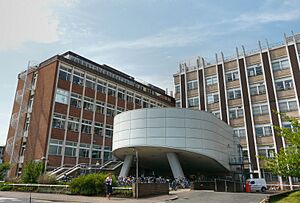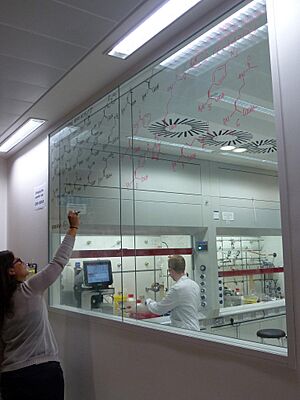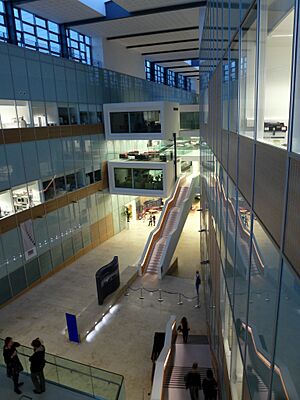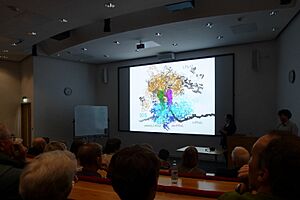MRC Laboratory of Molecular Biology facts for kids

The new building of the LMB viewed from the Cambridgeshire Guided Busway bridge in June 2013
|
|
| Abbreviation | MRC LMB |
|---|---|
| Location |
|
| Fields | Molecular biology |
|
Director
|
Jan Löwe |
|
Parent organization
|
Medical Research Council |
The Medical Research Council (MRC) Laboratory of Molecular Biology (LMB) is a famous research center in Cambridge, England. It played a huge role in the exciting discoveries of molecular biology in the 1950s and 1960s.
Since then, the LMB has continued to be a top medical research lab. Scientists there work to understand how living things work at a tiny level. They study atoms, molecules, and cells using many different methods. Their main goal is to use this knowledge to help solve big problems in human health.
A new building for the LMB was opened in May 2013 by Queen Elizabeth II. It is located near the old site on the Cambridge Biomedical Campus. The road outside the new building is named Francis Crick Avenue. Francis Crick was a scientist from the LMB who won a Nobel Prize in 1962. He helped discover the spiral shape of DNA in 1953.
Contents
- History of the LMB: A Journey of Discovery
- Early Days: How the Lab Began (1947-1961)
- A Year of Amazing Discoveries (1953)
- The New LMB Opens Its Doors (1962)
- Molecular Biology: Discoveries After 1962
- Studying Tiny Worms: C. elegans Research
- Understanding Our Immune System: Immunology
- Exploring the Cell: Cell Biology
- Studying the Brain: Neurobiology
- Making Better Tools: Instrumentation
- How the LMB Works: A Simple Structure
- Research Groups at the LMB
- Famous Scientists and Nobel Prizes
History of the LMB: A Journey of Discovery
Early Days: How the Lab Began (1947-1961)
Max Perutz came to the University of Cambridge in 1936 from Austria. He joined a group studying crystals using X-rays. Here, he started his important work on hemoglobin, a protein in blood. Lawrence Bragg, a leader in X-ray studies, became a big supporter of Perutz's group.
After World War II, many scientists who studied physics started looking at biology. They brought new ways of thinking and new skills. John Kendrew joined Perutz's group in 1946 to study myoglobin, a protein like hemoglobin.
In 1947, the Medical Research Council (MRC) decided to create a special group. This group was called the "MRC Unit for the Study of the Molecular Structure of Biological Systems." By 1948, Hugh Huxley joined to study muscles. In 1949, Francis Crick joined, working on protein crystals. Then, in 1951, James Watson also joined the team.
A Year of Amazing Discoveries (1953)
The year 1953 was truly amazing for science. Watson and Crick discovered the DNA double helix. This showed how living information is stored and copied during cell division. Perutz found a way to figure out the 3D shapes of proteins like myoglobin. He used X-rays and a special method with heavy metal atoms. Hugh Huxley also found that muscles contract using a "sliding filament mechanism."
In 1957, the group's name changed to the "MRC Unit for Molecular Biology." That same year, Vernon Ingram found that sickle cell anaemia is caused by a tiny change in the hemoglobin molecule. Sydney Brenner also joined the Unit. In 1958, Crick wrote about the "central dogma of molecular biology." This explained how genetic information flows in cells.
In 1961, Brenner helped discover messenger RNA (mRNA). He and Crick also showed that the genetic code is read in groups of three. All this important work happened in small, simple buildings.
The New LMB Opens Its Doors (1962)
The MRC built a brand new lab called the LMB on the edge of Cambridge. The Unit moved there in early 1962. Fred Sanger's group also joined them. Sanger had found ways to figure out the order of amino acids in proteins. He won the Nobel Prize in Chemistry in 1958 for finding the sequence of insulin. Aaron Klug also moved from London to join the new lab.
Queen Elizabeth II officially opened the new LMB in 1962. Later that year, Kendrew and Perutz shared the Nobel Prize for Chemistry. Crick and Watson shared the Nobel Prize for Physiology or Medicine. The LMB building later became part of the new Addenbrooke's Hospital complex.
Max Perutz was the chairman of the new LMB. It had three main parts: Structural Studies (led by Kendrew), Molecular Genetics (Crick), and Protein Chemistry (Sanger). About 40 scientists worked there at first. This number quickly grew, especially with many visiting scientists from the US.
Molecular Biology: Discoveries After 1962
The 1960s were a time of great growth in molecular biology. Scientists figured out the detailed 3D shapes of many proteins. These included myoglobin, hemoglobin, and chymotrypsin. Crick put together the full genetic code from discoveries around the world.
Joan A. Steitz found the "punctuation marks" in messenger RNA. These tell cells where to start and stop making a protein. Crick also suggested how tRNA molecules read the messenger RNA. Sanger created new ways to sequence RNA and later DNA molecules. He won a second Nobel Prize in Chemistry in 1980 for this. Later, John Sulston played a key role in sequencing entire genomes.
Scientists also learned how tRNA molecules are processed to work correctly. This led to the discovery of ribozymes. Klug solved the atomic structure of the first tRNA molecule. He also discovered zinc fingers, winning the Nobel Prize for Chemistry in 1982. John E. Walker and Andrew Leslie figured out the structure of ATP synthase. Walker shared the Nobel Prize for Chemistry in 1997 for this.
In 1990, Kiyoshi Nagai started working on the spliceosome. This is a complex machine that helps process RNA. His group published its first full structure in 2016. Venkatraman Ramakrishnan solved the structure of the ribosome. He shared the Nobel Prize for Chemistry in 2009 for this work.
Studying Tiny Worms: C. elegans Research
Towards the end of the 1960s, scientists realized that their molecular biology methods could solve new problems.
In 1965, Sydney Brenner started studying the genetics of a tiny worm called C. elegans. This group grew, and many visitors came to work on the worm. John Sulston mapped out how every cell in the worm develops. John Graham White mapped the entire nervous system of the worm. Robert Horvitz helped with the cell development. He shared the Nobel Prize in 2002 with Brenner and Sulston. Jonathan Hodgkin found the genetic steps that control if a C. elegans worm becomes male or female.
John Gurdon found a way to use frog eggs to study how genetic information is used. He shared the 2012 Nobel Prize for his earlier work. This work showed that genetic information stays complete as an animal develops.
Peter Lawrence studied how body patterns form in fruit flies. He helped discover how different parts of the fly's body plan are set.
Understanding Our Immune System: Immunology
César Milstein had been studying how antibodies change. He and Georges Köhler discovered how to make monoclonal antibodies. These are special antibodies that are all exactly the same. They shared the Nobel Prize in 1984 for this discovery.
Greg Winter took this work further. He found new ways to engineer antibodies using a method called phage display. This allowed scientists to create new human antibodies. He shared the Nobel Prize in Chemistry in 2018 for this. Monoclonal antibodies are now very important in medicine.
Michael Neuberger discovered how antibodies become so varied. This discovery helps us understand how our bodies can make many different antibodies to fight new germs.
Exploring the Cell: Cell Biology
The focus of the lab shifted to studying cells and how they develop. The Molecular Genetics division was renamed Cell Biology. Mark Bretscher discovered how proteins are arranged in the cell membrane of red blood cells. Richard Henderson and Nigel Unwin developed a way to study the structure of tiny cell parts using electron crystallography. They used this to study a bacterial protein.
Barbara Pearse discovered the main parts of clathrin-coated vesicles. These are tiny sacs that cells use to take things in. Scientists also learned how proteins get to the right places in the cell. This work was done by Bretscher, Hugh Pelham, and Sean Munro. John Kilmartin studied the spindle pole bodies in yeast cells. These are important for moving chromosomes during cell division.
Scientists at the LMB have also been very interested in the structure of chromosomes. Roger Kornberg discovered the nucleosome, which is the first way DNA folds up. This work continues to help us understand how DNA is packed inside cells.
Studying the Brain: Neurobiology
A new Neurobiology division was created in 1993. It covers many different topics about the brain. Nigel Unwin has continued to improve electron crystallography. He used it to figure out the structure of the acetylcholine receptor. This receptor helps many brain cells communicate. Michel Goedert has found different proteins linked to Alzheimer's disease.
Making Better Tools: Instrumentation
Scientific breakthroughs often happen because of new technology. The LMB has been a leader in creating many new tools. Some big examples include methods for sequencing DNA, engineering proteins and antibodies, building new X-ray equipment, and inventing the scanning confocal microscope.
How the LMB Works: A Simple Structure
The LMB has a very simple way of running things. The parent organization, the MRC, gives the lab a lot of freedom. Division leaders can run their groups as they think best.
Max Perutz believed that everything should make it easier for scientists to do their work. The LMB had one big budget. There were no personal budgets for scientists. All equipment was shared. The lab had the best equipment and was well funded by the MRC. Scientists could get chemicals and supplies easily. Michael Fuller was very important for the smooth daily running of the lab.
There was no strict hierarchy. Everyone used first names. Most people met in the canteen, which helped scientists from different groups talk and work together. Today, the LMB has about 450 scientists. About 130 are postdoctoral researchers (scientists who have finished their PhD) and 110 are students. The new building, opened in 2013, has seminar rooms named after famous LMB scientists: Sydney Brenner, Aaron Klug, César Milstein, and Frederick Sanger. The main lecture hall is named after Max Perutz.
Research Groups at the LMB
As of 2023[update] there are about fifty group leaders at the LMB. These groups are part of four main divisions: Cell Biology, Neurobiology, Protein and Nucleic Acid Chemistry, and Structural Studies. Some of the group leaders As of 2023[update] include:
- Matteo Allegretti
- Radu Aricescu
- David Barford
- Buzz Baum
- Anne Bertolotti
- Tanmay A. M. Bharat
- Simon Bullock
- Albert Cardona
- Andrew Carter
- Jason Chin
- Gerry Crossan
- Emmanuel Derivery
- Benjamin Ryskeldi-Falcon
- Juliette Fedry
- Michel Goedert
- Ingo Greger
- Joe Greener
- Michael Hastings
- Ramanujan Hegde
- Philipp Holliger
- Leo James
- Gregory Jefferis
- Patrycja Kozik
- Madeline Lancaster
- Jan Löwe
- Kate McDole
- Andrew McKenzie
- Harvey McMahon
- Liz Miller
- Sean Munro
- Garib Murshudov
- Kelly Nguyen
- John O'Neill
- Lori Passmore
- Venki Ramakrishnan
- Felix Armin Randow
- Jing Ren
- Christopher Russo
- Julian Sale
- William Schafer
- Sjors Scheres
- Marta Shahbazi
- John Sutherland
- Chris Tate
- Marco Tripodi
- Ana Tufegdzic Vidakovic
- Roger L. Williams
- Joseph Yeeles
- Suyang Zhang
- Marta Zlatic
Emeritus Scientists
The LMB is also home to a number of Emeritus Scientists. These are scientists who continue their research at the lab after they have officially retired. They include:
- Brad Amos
- Mariann Bienz
- Richard Anthony Crowther
- Philip Richard Evans
- Alan Fersht
- Michael Gait
- Richard Henderson
- Rob Kay
- John Kendrick-Jones
- John Kilmartin
- Peter Lawrence
- Andrew Leslie
- David Neuhaus
- Hugh Pelham
- Daniela Rhodes
- Murray Stewart
- Andrew Travers
- Nigel Unwin
- Greg Winter
Famous Scientists and Nobel Prizes
Many scientists from the LMB have won or shared Nobel Prizes for their amazing work.
Nobel Prize Winners from LMB Staff
- Frederick Sanger (1958 & 1980)
- John Kendrew (1962, shared with Max Perutz)
- Max Perutz (1962, shared with John Kendrew)
- Francis Crick (1962, shared with Maurice Wilkins and Jim Watson)
- Jim Watson (1962, shared with Francis Crick and Maurice Wilkins)
- Aaron Klug (1982)
- César Milstein (1984, shared with Georges Köhler and Niels Jerne)
- Georges Köhler (1984, shared with César Milstein and Niels Jerne)
- John Walker (1997, shared with Paul D. Boyer and Jens Christian Skou)
- Sydney Brenner (2002, shared with Robert Horvitz and John Sulston)
- Robert Horvitz (2002, shared with Sydney Brenner and John Sulston)
- John Sulston (2002, shared with Sydney Brenner and Robert Horvitz)
- Venkatraman Ramakrishnan (2009, shared with Thomas A. Steitz and Ada E. Yonath)
- Michael Levitt (2013, shared with Martin Karplus and Arieh Warshel)
- Richard Henderson (2017, shared with Jacques Dubochet and Joachim Frank)
- Greg Winter (2018, shared with Frances H. Arnold and George P. Smith)
Nobel Prize Winners Who Visited or Studied at LMB
These scientists won a Nobel Prize for work they did or started while visiting the LMB:
- Sid Altman (1989)
- Richard J. Roberts (1993)
- Michael Smith (1993)
- Roger Kornberg (2006)
- Andrew Fire (2006)
- Elizabeth Blackburn (2009)
- Thomas A. Steitz (2009)
- Marty Chalfie (2008)
- John Gurdon (2012)
- Martin Karplus (2013)
- Arieh Warshel (2013)
- Morten Meldal (2022)
Other Notable Scientists from LMB
Many other important scientists have worked at the LMB. Here are some of them:
- Jerry Adams
- David Agard
- Julie Ahringer
- M. Madan Babu
- Leslie Barnett
- Alex Bateman
- David M. Blow
- Andrea Brand
- Steven E. Brenner
- Elizabeth Blackburn
- George Brownlee
- Cyrus Chothia
- Suzanne Cory
- Richard M. Durbin
- Sean Eddy
- Roger Freedman
- Mark Bender Gerstein
- Toby Gibson
- Julian Gough
- Gillian Griffiths
- Richard Harland FRS
- Stephen C. Harrison
- Brian S. Hartley
- Jonathan Hodgkin
- Kenneth Holmes
- Philip Ingham
- Robert Insall
- David Ish-Horowicz
- Cynthia Kenyon
- Judith Kimble
- Maria Leptin
- Arthur M. Lesk
- Harvey Lodish
- Philippa Marrack
- Laura Machesky
- Yanlan Mao
- Andrew McLachlan
- Morten P. Meldal
- Barbara J. Meyer
- Alan Munro
- Kiyoshi Nagai
- Michael Neuberger
- Mary Osborn
- Ketan J. Patel
- Barbara Pearse
- Richard Perham
- Nicholas Proudfoot
- Terence Rabbitts
- Julian Rayner
- Akhilesh Reddy
- Margaret Robinson
- Michael Rossmann
- Gerald M. Rubin
- Guy Salvesen
- Gebhard Schertler
- Tilman Schirmer
- Melina Schuh
- Magdalena Skipper
- Alan Smith
- Peter Karl Sorger
- Eileen Southgate
- James Spudich
- Joan A. Steitz
- Susan S. Taylor
- Sarah Teichmann
- Jean Thomas
- Ashok Venkitaraman
- Alan John Warren
- Harold M. Weintraub
- John Graham White
- Alison Woollard
- Mitsuaki Yoshida





